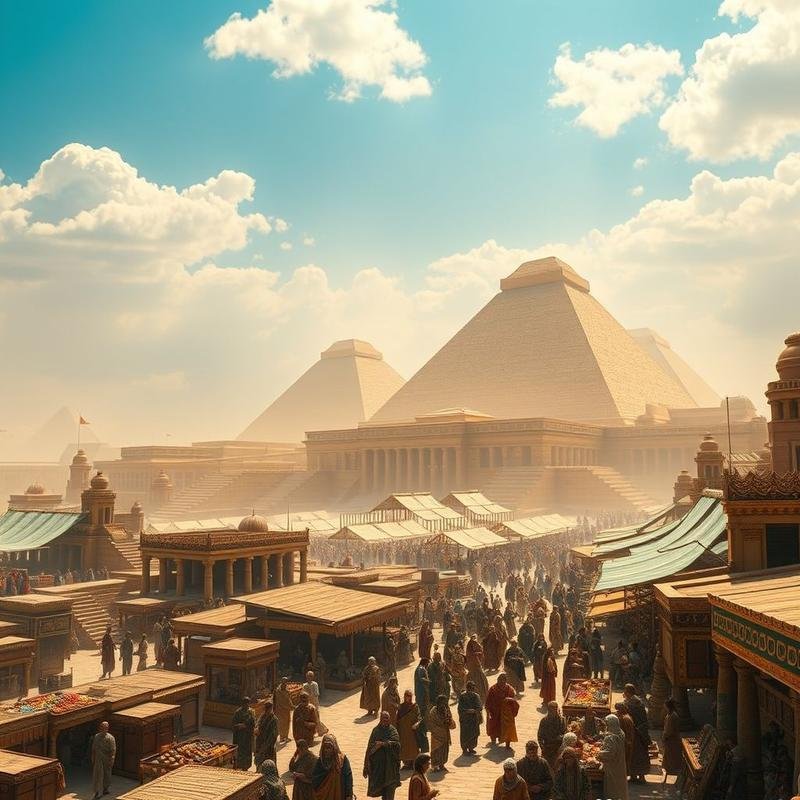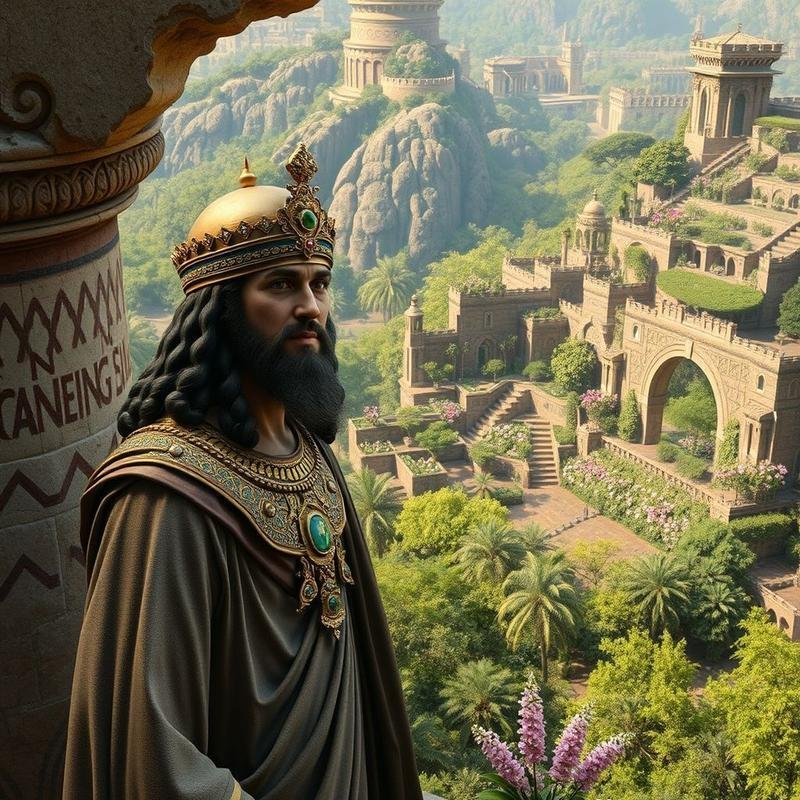The Hanging Gardens of Babylon: Legend, Reality, and Their Enduring Relevance.

Hanging Gardens of Babylon: Myth vs. Reality
Babylon: the very name evokes images of opulent palaces and bustling marketplaces, a civilization with audacious aspirations. Situated on the fertile Mesopotamian plains between the Tigris and Euphrates rivers, this ancient metropolis flourished as a center of innovation, a cradle of mathematics, astronomy, and law. The Code of Hammurabi, inscribed on a basalt stele around 1754 BC, remains a compelling testament to its legal system. Yet, within this rich historical tapestry, a perplexing silence surrounds one of Babylon’s most enduring legends: the Hanging Gardens. Described centuries later by Greek historians such as Diodorus Siculus and Quintus Curtius Rufus, these verdant terraces, purportedly constructed by King Nebuchadnezzar II around 600 BC to assuage his homesick Median wife, Amytis, are conspicuously absent from Babylonian cuneiform texts and archaeological discoveries. No contemporary inscription alludes to their existence, no royal decree celebrates their construction. This absence, this profound void in the historical record, deepens the enigma, transforming them from a potential reality into an enduring mystery. Could such a marvel truly have existed, leaving behind no trace but anecdotal accounts?
Whispers of Paradise
The silence of Babylon is broken only by echoes from afar. Our earliest accounts originate not from the city itself, but from Greek and Roman writers centuries later. These accounts, tantalizing yet potentially inaccurate, paint a vivid picture of a verdant marvel. Berossus, a Babylonian priest writing in Greek around 290 BC, offers what may be an early description. Though his original works survive only in fragments quoted by later authors, he attributes the gardens to Nebuchadnezzar II, built to appease his Median wife, Amytis, echoing the familiar narrative. However, the veracity of this attribution remains contested. Diodorus Siculus, writing in the 1st century BC, provides a more detailed, almost architectural description, emphasizing the tiered construction, vaulted ceilings, and sophisticated irrigation system drawing water from the Euphrates. Quintus Curtius Rufus, a Roman historian of the 1st century AD, further elaborates on the gardens’ location and scale, placing them near the citadel. However, it is crucial to acknowledge the temporal and geographical distance separating these writers from the purported construction. They relied on secondary sources, hearsay, and potentially embellished accounts passed down through generations. Furthermore, the political climate and cultural biases of these writers undoubtedly shaped their narratives. Were they simply recounting a fantastical tale, or were they attempting to legitimize the power and grandeur of the empires they served by attributing such a marvel to a distant, exotic land? The absence of Babylonian corroboration casts a long shadow on these classical accounts, compelling us to consider them not as definitive proof, but as intriguing glimpses filtered through the lens of foreign perception.
The Archaeological Quest
This allure has driven countless expeditions into the heart of Mesopotamia, each grappling with the formidable challenges of excavating Babylonian sites. The water table alone presents a significant obstacle, often flooding excavations and obscuring vital evidence. Moreover, the very mudbrick construction that defined Babylonian architecture has proven its own undoing; millennia of weathering have reduced many structures to featureless mounds, concealing their secrets beneath layers of sediment and time. Despite these daunting obstacles, archaeologists have relentlessly pursued the elusive gardens. Robert Koldewey, excavating Babylon between 1899 and 1917, unearthed vaulted structures near the city’s Southern Palace, initially identifying them as the gardens’ foundations. This identification has been widely challenged. The vaults’ location, far from the Euphrates, raises serious doubts about the feasibility of irrigating such elaborate gardens. Furthermore, the absence of any textual corroboration from Babylonian sources linking these vaults to the gardens remains a significant problem. Intriguingly, an alternative theory has gained traction in recent years: that the Hanging Gardens were not located in Babylon at all, but rather in Nineveh, the capital of the Assyrian Empire. Stephanie Dalley, an Oxford scholar, has meticulously argued that the gardens were the creation of King Sennacherib in the 7th century BC. Dalley points to Assyrian reliefs depicting lush gardens, as well as textual evidence describing Sennacherib’s extensive irrigation works. She suggests that the classical writers, unfamiliar with Mesopotamian geography, may have confused Babylon with Nineveh, attributing the gardens to the more famous city. This theory, while compelling, is not without its detractors, and so the debate continues to fuel the search for definitive proof, wherever it may ultimately lie, buried beneath the sands of time.
Engineering Marvel or Mythical Creation?
The allure lies not just in their legendary beauty, but in the sheer audacity of their purported construction. To envision terraced gardens rising, perhaps seventy-five feet above the Babylonian plain, demands a profound consideration of the engineering challenges. The very foundation presents a problem: the alluvial soil of Mesopotamia, while fertile, is notoriously unstable. Massive stone platforms, possibly employing brickmaking techniques involving kiln-fired bricks and bitumen mortar – a technology certainly available at the time – would have been essential to distribute the immense weight. The most perplexing aspect remains the irrigation system. How were vast quantities of water, drawn from the Euphrates or perhaps even distant sources, lifted to the highest terraces? Continuous, powered irrigation was paramount. While Sennacherib’s innovations in Nineveh suggest the possibility of irrigation systems, were their scale and efficiency sufficient? Did they rely on a shaduf system, demanding relentless manual labor to raise buckets of water? Or, as some speculate, did they employ a more sophisticated chain pump, powered by animals or even a rudimentary water wheel? Furthermore, consider the waterproofing. Preventing the tons of water used for irrigation from seeping into the foundations and causing structural collapse would have required truly innovative solutions. Layers of reeds, bitumen, and lead sheeting have been proposed, but definitive archaeological evidence remains elusive. The absence of readily available stone for such extensive construction in the Babylonian plain itself further complicates the picture, suggesting a massive logistical undertaking to transport materials from distant quarries. Given these monumental challenges, are they a testament to human ingenuity or simply an elaborate myth? The technological capabilities of the time, while impressive, strain against the sheer scale described by classical authors, leading some to question whether the reality was a scaled-down version embellished over centuries into the legendary wonder we know today.
The Psychology of Paradise: Why We Believe
But why, when faced with archaeological ambiguity, does the myth stubbornly persist? The answer resonates from the depths of the human psyche, residing in our enduring longing for paradise – a perfect, untainted world. From the Garden of Eden to Shangri-La, humanity has consistently conjured idyllic realms, sanctuaries from the often brutal realities of existence. The Hanging Gardens, whether real or imagined, tap directly into this primal desire. Consider the cultural context of the ancient world. Life was often harsh – marked by disease, relentless warfare, and crushing scarcity. The vision of a lush, elevated oasis, a testament to human ingenuity triumphing over the limitations of nature, offered a powerful and alluring counterpoint to this harsh reality. It symbolized control over the environment, a hard-won victory against chaos. The gardens became a potent symbol of Babylonian power and sophistication, a symbol magnified and embellished through the eager lens of Greek and Roman writers, keen to portray the exotic wonders of the East. Was this embellishment intentional or simply a product of their own cultural biases? The power of storytelling also plays a crucial role in perpetuating the myth. The accounts of figures like Berossus and Diodorus Siculus, though potentially embellished across countless retellings, painted vivid pictures that captured the imagination of subsequent generations. These narratives, passed down through centuries, solidified the Gardens’ place in the collective consciousness, transforming them from a potential historical reality into an enduring cultural myth. The lack of definitive archaeological proof, paradoxically, may even enhance the myth’s appeal. It allows for endless speculation and reinterpretation, ensuring that the Hanging Gardens continue to bloom, vibrant and unforgettable, in the fertile ground of human imagination.
The Enduring Legacy
Beyond the painstaking excavations and scholarly debates, the true legacy isn’t necessarily in their physical existence. Instead, it lives on, undeniably, within the rich tapestry of human imagination. For centuries, artists, writers, and dreamers have conjured their own versions of this verdant paradise, each reflecting the aspirations – and anxieties – of their time. Romantic poets envisioned the Gardens as a symbol of untamed beauty, the sublime power of nature itself. Later, in the 20th century, some interpretations portrayed the Gardens as a testament to human ingenuity, a beacon of hope bravely shining amidst the devastation of war. This enduring allure speaks to our inherent need for utopian ideals, for tangible representations of harmony and abundance. The myth, therefore, transcends the boundaries of mere historical accuracy; it becomes a mirror, reflecting our collective yearning for a better world. It is a testament, ultimately, to the power of myth to inspire and shape our future aspirations.
A Garden in the Mind
And so, the true marvel isn’t just about reconstructed irrigation or terraced platforms. It lies within the fertile grounds of human imagination. These ethereal gardens, unseen yet perpetually verdant, thrive in narratives spun across millennia, from Berossus’s accounts of Nebuchadnezzar’s longing. They represent our enduring fascination with paradise, a yearning for a lost Eden, reflected in Mesopotamian myths of Dilmun and Sumerian tales of plenty. They are a testament to human ingenuity—not merely in engineering, but in the crafting of stories that transcend time. A reminder that the most breathtaking landscapes often exist not in the physical realm, but within the boundless capacity of the human spirit to dream, to wonder, and to cultivate beauty in the face of stark realities. They are, perhaps, a garden grown in the mind, a potent symbol of what humanity strives to create, even when faced with the most challenging of circumstances. The Hanging Gardens, in their ambiguity, serve as a constant reminder of our








